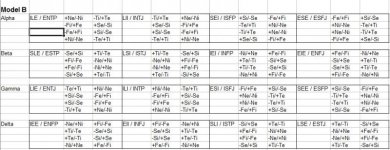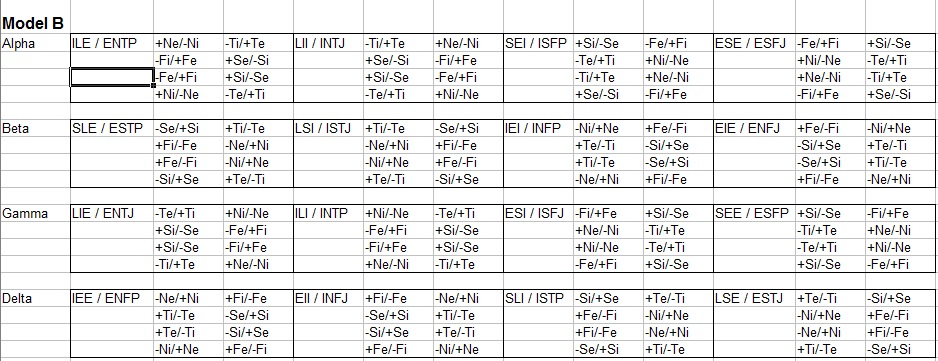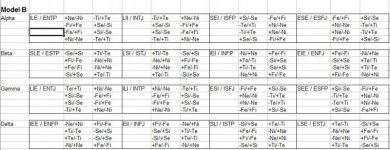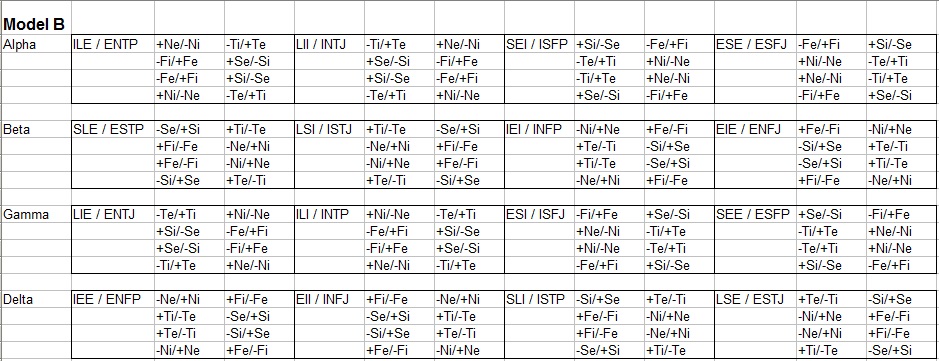Retmeishka
New member
- Joined
- Jan 13, 2011
- Messages
- 239
- MBTI Type
- ISTP


I just had an understanding today of what the 'global' versus 'local' means. Sometimes if you just word things differently, it becomes understandable. This is an oversimplified definition of these information elements - they actually have many different aspects to them, and I have not yet gathered all of the definitions into one place. Again, this is *oversimplified* to make it understandable. Many of the nuances are missing.
The one definition that I am focusing on here is: of others, versus of yourself. I am only beginning to understand this insight, so it is a work in progress. I am still trying to define introverted and extraverted sensing in ways that sensors would agree with and recognize, in their own words. My descriptions of all of my own weak functions are going to be lame sounding. I am most interested in trying to describe all the various forms of sensing.
Minus = of others ("global")
Plus = of yourself ("local")
-Fe = feelings of others. Outwardly expressed emotions of other people, individuals or groups of people. (Note, these people are also expressing their own feelings too, which is why I say this definition is oversimplified - I haven't explained it all yet.)
+Fe = feelings of yourself. Your own feelings from moment to moment, expressed outwardly.
-Fi = relationships of others, inward feelings of others. (I'm not opposed to it myself, but, I read an article where someone explained why they were opposed to gay marriage. Gay marriage = the relationships of others. They said that the children adopted by those families would have benefited by having parents of both genders. Talking about children's relationships with their parents = the relationships of others.)
+Fi = relationships of your own, inner feelings of your own (I know this person, his/her name is xyz, I have a relationship with them.)
-Te = the work processes of others. You can look at a corporation and see the work being done by everyone. Other people's work might be going well or it might be going badly. You can learn about and study processes as an abstraction: how this work process is done, what is this technique, algorithm, method, that others are doing. (note, by using the word 'process,' I might be blending this with Ni.) This is about 'how it's done.' How others do it, how everyone does it, how we all are doing it. Also, the logic of how objects interact with other objects. Like, a chemical mixes with another chemical and produces a third chemical. Again, these people are all still doing their own work too, which I am not sure how to explain.
+Te = my own work. I am constantly doing something, making stuff happen. I pushed the button and the computer did something. Also, another nearby person might be trying to make something work, and I can see what they're doing and what they have to do to make it work. I think the definition of 'local' doesn't always mean yourself, it can also mean some physical person near you that you can see.
-Ti = the logic of others. I'm not sure how to define this yet. I don't know why, but I'm drawing a blank on this, lol. The measurements and theories of others? The laws and principles of others? I dunno. I actually ought to go and collect all of the definitions I have read of all these information elements instead of trying to write it myself. Maybe that's my -Ti right there. Definitions written by others?
+Ti = my own logic. Again, not sure on this. I associate +Ti with making measurements and getting specific numbers, which is endless and infinite. You can measure exactly how tall the tree is, you can measure the distance around the tree and get an exact number for that, you can measure the diameter of the tree, you can measure every detail of the tree and get infinity numbers, and this will never end. A business person or CEO also does this, getting statistics on everything, every detail of their business, and it is impossible to run out of things to measure.
-Se = objects others see. This one is particularly interesting. I had a new insight on this. -Se is an awareness of the objects that other people can see. For instance, you're playing football, people are running all around, and one person looks at another person, and passes them the ball. You noticed that Person A was able to see Person B. You might say, 'She can see him. He can't see her. He didn't catch the ball.' This sense also enables you to sneak without being seen. You know that some other person can't see you. -Se = What others see. What everyone sees, what a group sees. I'm still working on this definition. -Se = the forces others make. I watched a video about martial arts. The guy was adapting to the forces made by the other, the other person's attacks, going with their flow. Another video talked about going in harmony with nature, the forces of nature, forces outside yourself. (*Edit, this might be -Te. +Te is, for example, one object striking another, or in a fight, one person punching another, so -Te might be the awareness of everyone else's 'strikes,' and moving yourself out of the way of them, I'm not sure of any of this yet. *)
+Se = objects I see. I see this thing right here in front of me. I talk about this or that object in the room, I point to it, I can go pick it up or touch it. I'm also able to sneak, but I feel sort of anxious and uncertain about it, like I'm not quite as strong at sneaking as I ought to be, in order to feel totally confident about it, and that's why I suspect that 'sneaking' and 'not being seen by others' is part of my 7th function, 3 dimensional instead of 4 dimensional. I'm still working on describing all the differences between +Se and -Se. +Se = the force that I myself make.
-Si = internal sensations of others. My cat Max is outside. I know that he's cold out there. I still don't completely understand this definition yet. I tend to talk about the lifestyles of everyone in society, so 'lifestyle' might also be part of Si. I'm not sure yet. It's kind of like 'How everyone lives.' How other people live.
+Si = internal sensations of myself, or of nearby people, specific people. How I live, as an individual.
-Ne = potentials of others. Groups of people, anyone, anonymous people, people as an abstraction. Does it also mean 'possibilities elsewhere?' I don't know how to define this since it's not a strong function for me and I've been preoccupied with defining more and more nuances of the sensing definitions.
+Ne = potential of myself, my own ideas which are new, things that I have generated, new ways of seeing things that I created by myself, or that some specific other person created.
-Ni = others' way of seeing things, others' interpretations and explanations. What this means to others, what this means to everyone.
+Ni = my own way of seeing things, my own meanings and interpretations. Some individual person and yourself have a specific meaning attached to something.
**************************
Again, this is very oversimplified, I can't say that enough. There are many different aspects of these functions that I did not mention here and have not yet collected all in one place. It was just the insight I had about 'of others, versus of yourself.' The words 'global' and 'local' don't really mean anything to me - they are too abstract. But if I translate it to plain language and say 'of others' and 'of myself,' all of a sudden, boom, I understand what they're talking about now.
Last edited:


